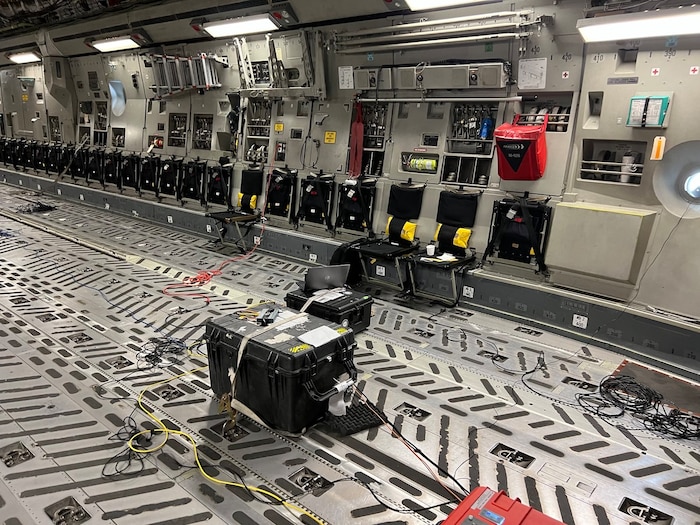The US Air Force has recently achieved a “groundbreaking” milestone with its MagNav project, as it successfully conducted real-time magnetic navigation (MagNav) during a flight on the C-17A Globemaster III.
The ‘Brahmastra’ Of Indian Air Force! Learning From Ukraine War, IAF Wants Sleek & Stealthy BrahMos-NG Missile To Deter The Dragon
This success establishes the service as the first organization to demonstrate this advanced technology in real-time on a Department of Defense aircraft, marking a significant milestone in the field.
The test was carried out by the collaborative efforts of the US Department of Air Force (DAF) – the Massachusetts Institute of Technology (MIT) Artificial Intelligence Accelerator (AIA) as part of the MagNav project.
The test received support from personnel associated with the Air Force Research Laboratory Sensors Directorate, MIT, MIT Lincoln Laboratory, and the Air Force Institute of Technology Autonomy and Navigation Center.
According to the USAF, the trial of real-time magnetic navigation (MagNav) occurred during the Golden Phoenix exercise held from May 11 to 15. This exercise was conducted at the test complex located at Travis Air Force Base (AFB) in California, United States.

The service said that the team involved in the MagNav project utilized the capabilities of artificial intelligence (AI) and machine learning by using the AIA’s calibration and positioning neural network.
This neural network was trained during the flight and accomplished the task in minutes using a commercially-available laptop.
“The team leveraged transfer learning from AI models built on previously collected C-17 data, which significantly accelerated the neural network training process,” the statement reads.
The collaborative effort focused on enhancing the neural network architecture of the AIA, which played a vital role in eliminating magnetic noise generated by the aircraft. This noise elimination process allowed precisely identifying the aircraft’s position by comparing it to a pre-existing magnetic map.
The team is anticipated to submit a comprehensive technical report to the US government, providing additional details regarding the system’s navigation accuracy. This report will offer valuable insights and findings derived from the MagNav project.
Furthermore, the successful demonstration of this technology opens doors for the Department of Defense (DoD) to utilize it in various other aircraft and platforms. These include small uncrewed aerial systems, hypersonic glide vehicles, and submarines.
Navigating Beyond GPS
Maj. Kyle McAlpin, the AIA MagNav liaison, expressed great enthusiasm for the project’s successful outcome.
He highlighted the concern of pilots regarding single points of failure and emphasized the need for reliable navigation systems beyond GPS.
McAlpin mentioned that the US military’s strategy documents acknowledge the over-reliance on GPS and the importance of diversifying navigation capabilities.
He further explained that to achieve unassailable positioning and navigation in future conflicts, it is crucial to augment GPS with alternative methods such as celestial navigation, signals of opportunity, visual navigation, and magnetic navigation.
The successful transition of MagNav from the conceptual stage at MIT and MIT Lincoln Laboratory to an operational aircraft represents a noteworthy milestone.

The US military officer further emphasized that this achievement paves the way for other branches of the military to adopt similar technologies and expands the potential application of MagNav to new platforms.
As China and Russia continue to advance their GPS spoofing capabilities, there is a growing need for the US military to adapt and prepare for operations in GPS-denied environments.
Satellite-based GPS systems could be at risk of disruption in a future conflict involving orbital warfare. This underscores the urgent requirement for a more adaptable and comprehensive concept of operations for Positioning, Navigation, and Timing (PNT).
By adopting alternative methods, the US military seeks to ensure reliable and resilient navigation capabilities in any operational scenario.
This proactive approach aims to address the challenges posed by adversaries. It offers a compelling vision for a future-ready military capable of overcoming disruptions and maintaining a technological advantage in navigation.
Nonetheless, the Air Force commended the successful demonstration of MagNav on the C-17 as a notable milestone that propels navigation capabilities for the entire US Air Force.
This achievement highlights the groundbreaking collaboration between the AIA, MIT, MIT Lincoln Laboratory, and other partners, setting the stage for future advancements in navigation technologies.
According to the Air Force, the impact of these innovations extends beyond the Air Force, benefitting the broader aviation community as a whole.
- Contact the author at ashishmichel(at)gmail.com
- Follow EurAsian Times on Google News




